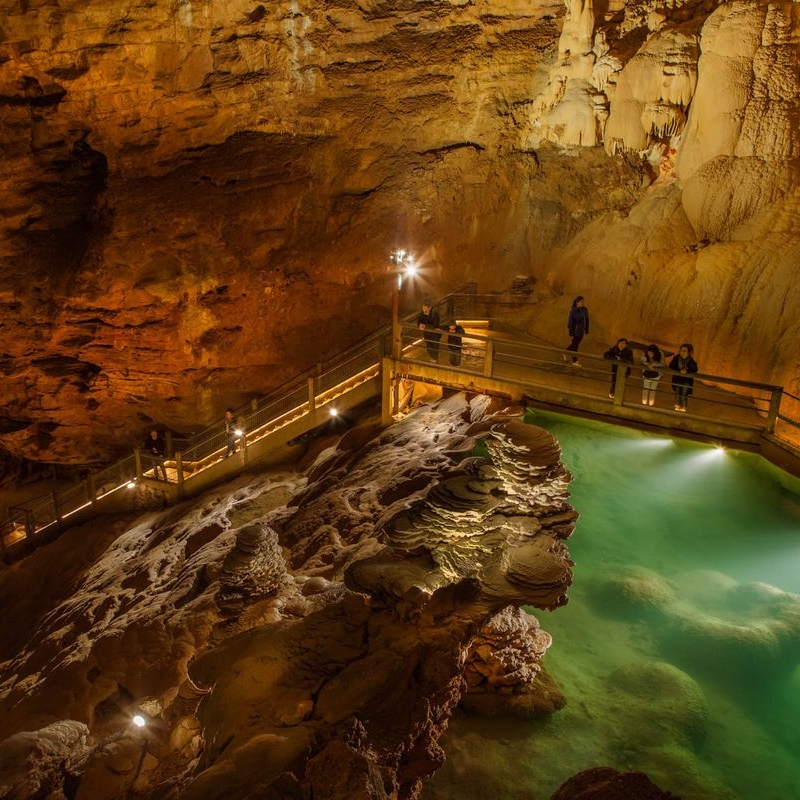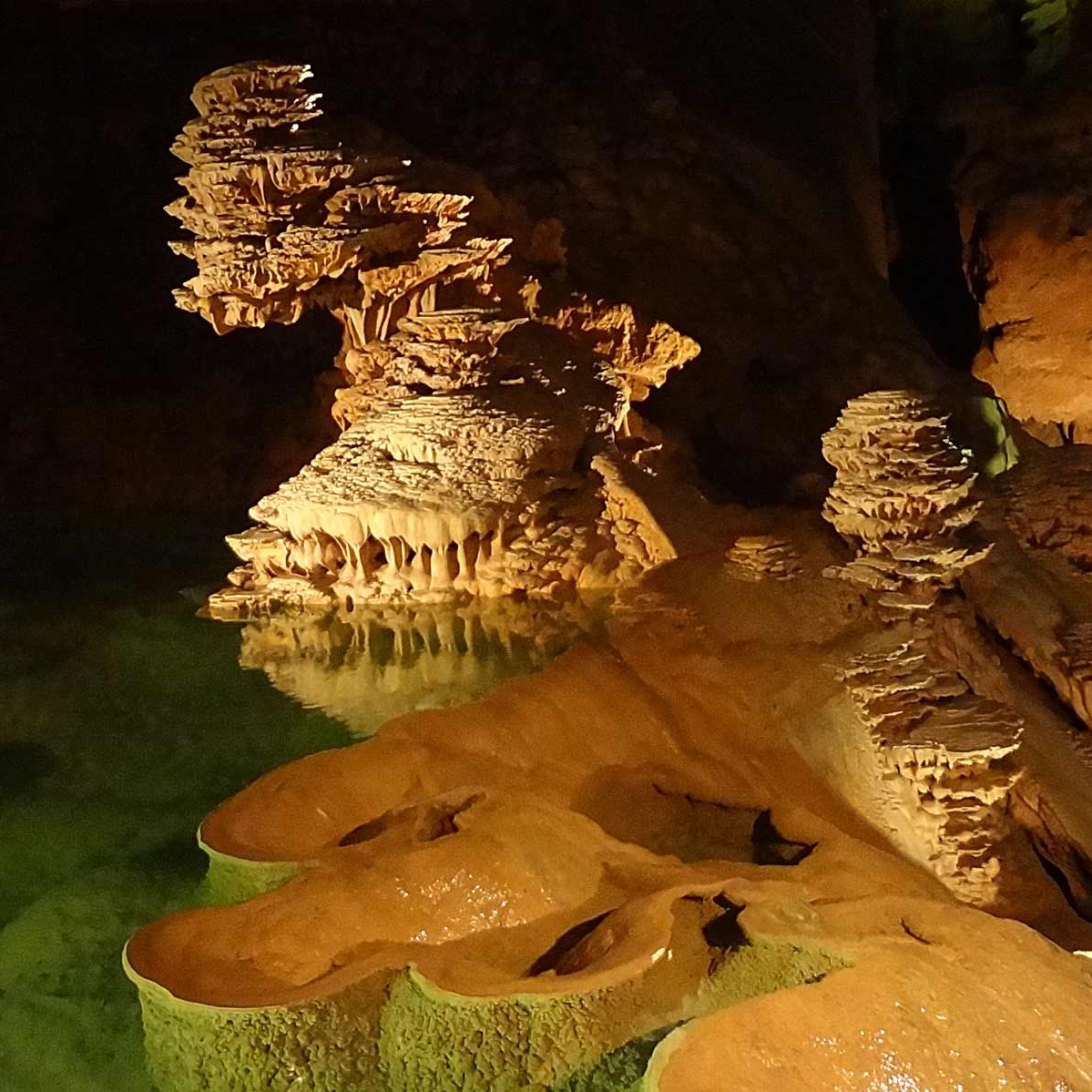Centered on the town of Sarlat and the river Dordogne, this is the classic Dordogne, with its limestone cliffs, castles (such as Beynac or Castelnaud) and picturesque villages such as Domme and La roque Gageac, and also its world-famous caves with their stalagmites and stalactites, and in several cases prehistoric paintings.
The French National Museum of prehistory is at Les Eyzies, while the grotto at Lascaux boasts the world's most famous prehistoric cave paintings. There are other prehistoric caves that can be visited at Font de Gaume and Cap Blanc, and even a prehistoric theme park, Prehistoparc.
We recommend 4 different day trips:
- Domme, La Roque Gageac, Castelnaud et Beynac
- Sarlat Les Eyzies, Grotte de Rouffignac
- Montfort, Carsac, Château de fenelon, Rocamadour
- St Génies, Lascaux, St Léon sur Vézère, La Roque St Christophe et Maison Forte de Reignac
DOMME
Perched on a breathtakingly high cliff that allows it to enjoy an exceptional view of the Dordogne valley and the neighbouring Most Beautiful Villages of La Roque-Gageac and Beynac-et-Cazenac. This creamy-stoned "bastide" or fortified village boasts a successful combination of architectural, natural and gastronomic heritage typical of Périgord Noir.
La Roque-Gageac
BEYNAC-ET-CAZENAC
10 kilometres southwest of Sarlat, on the banks of the Dordogne, and boasts an imposing castle, once besieged by Richard the Lion Heart, around which "lauze" stone slab-roofed houses with their creamy façades are built.
In Périgord Noir, at the foot of a south-facing cliff, the creamy stone houses with their "lauze" stone slab or brown-tiled roofs are mirrored in the waters of the River Dordogne where the famous "gabares" (traditional flat-bottomed boats) laden with goods used to pass in the 19C.
A warren of alleyways, virtually unchanged since the middle ages, lined with warm ochre stone houses, each with its own distinctive facade and ornately sculptured window embrasures, set off by the stone roofs and turrets, Sarlat a must for any tourist visiting the Dordogne. Sarlat’s Saturday market is excellent, teaming with life, an unforgetable experience from the street artists that throng there, to the wonderful fresh local produce. Sarlat comes to life in summer with its Drama Festival and Film Festival as well as non-stop street shows in the old quarter. Sarlat is an artists paradise with many small galeries including the famous “Herdin”, student of Salvador Dali.
THE CHATEAU DE CASTELNAUD
Officially listed as an Historic Site in 1966, stands high over the Dordogne valley, with magnificent views of the châteaux of Beynac and Marqueyssac and the medieval village of La Roque-Gageac. Open to the public since 1985, this one-time fortress is now given over entirely to displaying the art of warfare in the Middle Ages. Inside, it has a unique private collection of arms and armour, as well as furniture from the period; outside, you will find reconstructions of war machines, such as siege catapults, in actual size.
ROUFFIGNAC (huge cave)
Successively occupied by cave bears and prehistoric artists, it still beholds the spectacular testimonies of those passages. More than 250 animal figures are scattered in this underground maze, where they were left 140 centuries ago. Sat aboard an electric train, you will dive into the mysterious cave world and discover the art of the prehistoric hunter-gatherers. A privileged place of knowledge broadcasting, Rouffignac regularly receives scientific exhibitions.
THE CHATEAU DE MONTFORT
Placed high on a rocky ledge overhanging the village of Montfort, and the cliffs and broad meander in the Dordogne river below. Said to be destroyed and rebuilt four times, Chateau Montfort has had a turbulent history, and undergone a great deal of change during its 800 years existence.
ROCAMADOUR
A very popular destination for pilgrims and tourists alike. The spectacular natural and religious site perched high on a rocky plateau receives 1.5 million visitors each year. For pilgrims, Rocamadour's importance lies with the Shrine of Our Lady of Rocamadour, a complex of religious structures centered on a miraculous statue of the Virgin Mary and the tomb of an ancient saint. Tourists come to Rocamadour for its religious interest, historical significance, beautiful architecture, and most of all, for the spectacular views: Rocamadour is situated atop a rocky plateau overlooking the Alzou Valley
THE CASTLE OF CARSAC
The castle of Carsac is more linked with the cathars than most in the region, and the well known cathar 'leader' Bernard de Casnac lived in the chateau - while there he said he would 'cut into pieces all the catholics in the region' which seems slightly at odds with the peaceful objectives of the cathars! Such a statement was likely to arouse attention, and the Albigensian crusade under Simon de Montfort captured the castle, removed Casnac, and burned the chateau to the ground. It is curious that it was de Montforts name adopted by the castle that he destroyed! There is also a legend at the chateau that the daughter of Casnac was burned to death at Montfort, and that her ghost still haunts the chateau.
CHATEAU DE FENELON
This is a beautiful castle on a rocky promontory, surrounded by a triple wall and terraces, situated above the village of Saint Mondane between Sarlat and Souillac.Fenelon castle dates originally from the 13th century, but the castle we see today is more from the 16th century refurbishments by the owner, an important local gentleman who wanted to live in luxury. One of his children, Fénelon, was the author of a very celebrated story of Telemachus, much published and read in France during the 18th century.
PADIRAC CHASM
The limestone underlying almost two-thirds of the Lot is everywhere pierced with caves, chasms, caverns, galleries and potholes…although arid on top, with little surface water, it's a different story underground, as a visit to Padirac Chasm will show. This spectacular 75 m deep hole in the ground gives access to a subterranean river, along which you travel in a small boat to reach other caverns of truly impressive dimensions, as are the stalactites and stalagmites found in them. The whole system is natural: it was not properly explored until the 19th C., and recently, cave divers have managed to chart about 40 km of galleries within the network.
LASCAUX
The replication is meticulous and the paintings are absolutely gorgeous and have a level of sophistication making it hard to believe they were painted by pre-historic man. The colours of the walls are absolutely gorgeous, deep red, rich ochre and black being the dominant tints. The pictures are beautifully painted and show a sense of perspective and movement. The caves were discovered in 1940 by Marcel Ravidat and his dog, Robo. After discovering the entrance he and three friends (Georges Agniel, Simon Coencas and Jacques Marsal) forced their way into the caves and discovered the treasures of Lascaux. They told their teacher, who became the caves first curator, and soon after Father Henri Breuil, a pre-history expert, arrived on the scene. The caves were opened to the public after the Second World War in 1948, with Marcel Ravidat as one of the guides. The cave was closed in 1963 as exposure to air and enormous numbers of viewers led to first a risk from a green mould and later to a risk from calcium deposits covering the paintings.
SAINT GENIES
Saint Genies is a lovely little village between Montignac and Sarlat. At the centre of the village is a beautiful ensemble consisting of the chuch of Notre Dame de l'Assomption and the chateau. Saint Genies is dominated by the castle and church at the centre of the village. The church was built in the 12th century and has a fortified bell-tower dating from the 14th century.
St. LEON DE VEZERE
It is a beautiful village, set in a curve in the Vézere River. It is a small village, of houses in the attractive local stone joined by narrow meandering pathways and alleys. Remarkably for a village of this kind in this location, St Leon sue Vezere has not been overly renovated - rather 'sympathetically restored'. Many of the houses still have parts of their roofs made of stone which was the traditional roofing at one time.
LA ROQUE St. CHRISTOPHE
On a cliff overlooking a tranquil section of the River Vezere is the remains of a large troglodyte town. The cliff has evidence of use as a shelter for Neanderthal man (50.000 BC), Cro-Magnon man (25000 BC) and since then up until the Renaissance in 1588 when the trogolodyte town and fortress that had grown up was destroyed in the Wars of Religion. The town occupied 5 terraces in the cliff face using naturally hollowed out caves in the limestone cliff. Three hundred feet above the ground and more than half a mile long the Roque Saint Christophe really is a remarkable troglodyte development.
MAISON FORTE DE REIGNAC
Maison Forte de Reignac is a kind of fortified Manor House that has been built into the rock. The majority of its roof is the overhanging cliff that is above it. Its modest appearance on the outside belies the scale of the building on the inside. The Maison Forte de Reignac has been closed to the public until recently. It is now the only cliff-castle of its type in France that is so totally intact.
THE GROTTE DU GRAND ROC
The main cavern is a fairy grotto. It never enters out into a large space but rather a passage winds around and on either side are thousands of tiny and small stalactites clinging to the ceilings and crystallized and solidified rivers of calcified rock running down the walls. There are few large stalactites, stalagmites or columns in the cave and those there are almost seem out of place in this enchanted space. The magic is in the sheer number and amongst them are thousands of the rare 'excentriques' which are tiny stalactites of only a few centimeters long and about the thickness of a pencil but they shoot out in all directions in a manner which seems impossible and totally unlike your usual vertical stalactites and stalagmites.
Approaching the Grotte du Grand Roc
THE GARDENS DE MARQUEYSSAC
It is the most visited garden of the Périgord. A listed site, the romantic and picturesque gardens of Marqueyssac offer more than six kilometers of shaded paths bordered by 150000 hand-pruned box trees a hundred years old, the whole embellished with belvederes, waterways, rockeries and grassy clearings. The Belvedere, at 130 meters above the river, gives an exceptional view of the Dordogne valley with its castles and some of the most beautiful villages of France. Playgrounds, swings and huts. Workshop of the woodworker during the season. The gardens were designed by a student of André Le Notre - famous designer of the gardens of the Chateau de Versailles.














